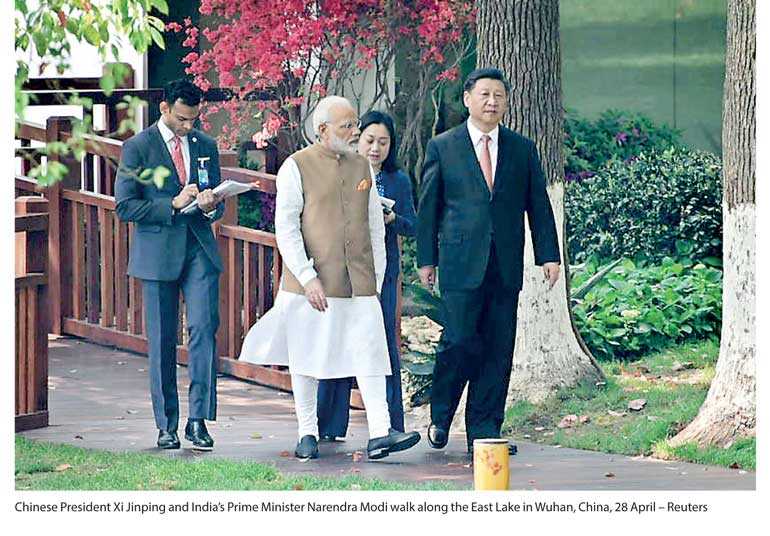Friday Mar 14, 2025
Friday Mar 14, 2025
Friday, 4 May 2018 00:00 - - {{hitsCtrl.values.hits}}

 US President Donald Trump once characterised North Korean dictator Kim Jong-un as the “Rocket Man”. More recently, as the historic inter-Korean summit took place at the Peace House of the Panmunjom village in the UN-sponsored Demilitarised Zone, Trump called him a “very honourable” leader. The most pervasive and inescapable news this week has been the historic summit between North and South Korea.
US President Donald Trump once characterised North Korean dictator Kim Jong-un as the “Rocket Man”. More recently, as the historic inter-Korean summit took place at the Peace House of the Panmunjom village in the UN-sponsored Demilitarised Zone, Trump called him a “very honourable” leader. The most pervasive and inescapable news this week has been the historic summit between North and South Korea.
Yet, a separate and less covered “informal summit” across the Yellow Sea, and one likely to be as consequential, is that of Chinese President Xi Jinping and Indian Prime Minister Narendra Modi. The summit, taking place at Chairman Mao Zedong’s summer villa in Wuhan of Hubei province in central China, is arguably more historic than the Korean peninsula to “reset” Sino-Indian relationship that goes back for millennia.
The two ancient civilisations—Hindu and Confucian—intersected long before the Han Dynasty (206 BC-220 AD) and Buddhist Emperor Ashoka the Great (304-232 BC) in India. Through the trading networks of China’s maritime and Silk Routes, a wide range of merchants, pilgrims, and knowledge systems enriched each culture. Among them was the dissemination of Buddhism from Sri Lanka and India to China, which had a transformative effect on the Confucian and Daoist culture.
For example, the earliest and later translations of Buddhist Sutras (scriptures) were revised and completed by famous scholar-monk Kumarajiva. Most significantly, he was the son of a Brahmin father from Indian Kashmir and a Chinese Kuchan princess—a “Chindian” (China and India) offspring.
If the two seemingly clashing cultures want to “reset” their evolving relationship, the starting point could well be Kumarajiva whose biological, intellectual, and spiritual connection bridge “Chindia” together. The importance of Kumarajiva is that he revolutionised the evolving Chinese Buddhism—the Mahayana tradition or the Chan Buddhism—without relying on the earlier translations through the concepts of Confucian and Daoist literature during the Eastern Jin Dynasty (317–420).
In recent years, Xi has used his foreign policy innovation in Buddhist diplomacy, especially with Sri Lanka. Modi has also invoked the Buddhist connection in his dealings with Sri Lanka and while visiting China’s Buddhist sites of shared Sino-Indian heritage, including the Daxingshan Buddhist Temple and the Giant Wild Goose Pagoda.
At the recent request of Modi, Beijing and New Delhi agreed to have the world’s two most populous nations meet for a “Chindia Reset”. The mindset of the Beijing leadership related to the timing and the location is critically important not only to overshadow the American-led denuclearisation of the Korean peninsula but to highlight the significance of Wuhan on the historic bank of the Han and Yangtze rivers that is considered the intellectual mecca for communist retreat of Chairman Mao and politburo members. Mao had written a poem, “Great plans are afoot: A bridge will fly to span the north and south; Turning a deep chasm into a thoroughfare,” from which theme both Xi and Modi could bring about greater prosperity and peace for the northern (China) and southern (Indian) civilisations connected by Buddhism.
Like US President Richard Nixon’s historic China visit to “reset” Sino-American relations after the Vietnam War and prior to his presidential re-election, Modi similarly had two reasons for the summit. First, India’s regional power has been somewhat weakened by China’s increasing economic engagement with its neighbours Bangladesh, the Maldives, Nepal, Pakistan, and Sri Lanka. More importantly, when Chinese troops entered the disputed Doklam (or Donglang in Chinese) tri-region of Bhutan-China-and-India last year, the Chinese military threatened the Indian forces as Beijing tried to extend the highway towards Bhutan, which has a “special relationship” with New Delhi.
Second, Modi is focusing on winning the national election in 2019 as domestic issues and political protests have seemingly weakened his Bharatiya Janata Party. But, Modi is a strategic leader, especially in a larger context of China’s transformative leadership with the Belt and Road Initiative (BRI) in Asia and beyond.
China and India—the second and seventh largest economies in the world—represent almost 40% of the world population and see each other as leaders of the “Asian century” in the “new era” of Xi that drive the engines of global economic growth, while the US and Europe belonged to the 20th century’s outdated game of geopolitics with Russia and the Middle East.
In the meantime, China advances it assertive foreign policy—with the BRI, the Asian Infrastructure Investment Bank, and the South and East China Sea disputes—while managing its relationships with the US and other European powers. Thus, China’s global vision is carefully guided and executed by the two pillars of Confucian bureaucracy and the Communist Party of China. The perception of China’s ruling mechanism is now being favourably viewed by many developing countries as more effective and efficient than the chaotic nature of India’s democratic governance—ultimately to serve its people better.
The rapid development and modernisation of China has, for example, proven that Beijing can govern its affairs locally and globally in confidence than what India has accomplished over the years. Behind only in military power, China has also surpassed—and growing—every economic and social development index compared with the US, according to Harvard Professor Graham Allison.
With the unprecedented global influence of China’s comprehensive power, Washington has tried to revitalise its old Indo-Pacific region’s “quad” strategy of Asian democracies of Australia, Japan, and India coming together as a unified force to counter China’s rise. Yet, America’s concerted military strategy only works if the US has the economic maturity to address the increased defence expenditures and the much-needed infrastructure development to “Make America Great Again.”
For India, a real alliance with the distant US is currently problematic, especially with the unreliable and chaotic Trump administration. The two populous markets need each other not only for economic reasons, but also Beijing and New Delhi have traditionally adhered to the Nonalignment Principle of Jawaharlal Nehru, the first prime minister of India, and Chairman Mao.
As former nonaligned countries, both Beijing and New Delhi shared an idealistic vision of independent national sovereignty—free of the colonial and Cold-War mentalities. As practical men of vision, the Wuhan summit between Xi and Modi is driven by national interest, the fear of external powers, and the pride in civilisational cultures. The two nations would cooperate in trade, commerce, and investment as China has increasing number of Indian workers, tourists, and students across Chinese universities.
The border disputes are of concerns for both countries. But, the challenges are being managed as India currently views China as a growing military power, surrounded by smaller nations of Bangladesh, Nepal, Pakistan, and Sri Lanka that are economically (and perhaps militarily in the future) aligned with Beijing’s realm of dominance. In such a case, India may likely consider the US as a potential democratic ally to counter to China’s assertive behaviour.
At this point in time, however, the calculus of being anti-China would not serve well for India whose cooperation has greater value in the global stage with China, especially in climate change and sharing global commons from which the US has departed. As a highly-decentralised governing system in India—with diverse ethnic, linguistic, and religious groups in a noisy democracy—only the test of time will tell whether it, or China’s form of governance with centralised control will prove to be more effective.
Indeed, like India, China has a similar diversity of ethnic, linguistic, and religious varieties but with a different governing model of centralised power. Like the starting point of Kumarajiva’s acculturation of the Sanskrit translations of Buddhist texts into Chinese through the then-prevailing hierarchical governance of Confucian society (with the Chinese characteristics), the “Chindia reset” may gradually have a transformative effect on China. It would certainly be more like Nixon, who triggered a domino effect that changed Sino-American relations, the “Chindian reset” could well be a new beginning to transform the most dynamic region into a “pacific” Century of Asia as the power shifts from the West to the East.
(The writer, a Harvard Kennedy School’s former Rajawali Senior Fellow, is an Associate-in-Research of the Fairbank Center for Chinese Studies at Harvard University and a Commissioner to the United States National Commission for UNESCO at the State Department. Professor Mendis is the author of “Peaceful War: How the Chinese Dream and American Destiny Create a Pacific New World Order’. He is a Senior Fellow of the Pangoal Institution in Beijing and a Distinguished Visiting Professor of Asian-Pacific Affairs at the Shandong University in Jinan, China. The opinions expressed here are his own and do not represent the institutions of his affiliations.)
Discover Kapruka, the leading online shopping platform in Sri Lanka, where you can conveniently send Gifts and Flowers to your loved ones for any event including Valentine ’s Day. Explore a wide range of popular Shopping Categories on Kapruka, including Toys, Groceries, Electronics, Birthday Cakes, Fruits, Chocolates, Flower Bouquets, Clothing, Watches, Lingerie, Gift Sets and Jewellery. Also if you’re interested in selling with Kapruka, Partner Central by Kapruka is the best solution to start with. Moreover, through Kapruka Global Shop, you can also enjoy the convenience of purchasing products from renowned platforms like Amazon and eBay and have them delivered to Sri Lanka.
Discover Kapruka, the leading online shopping platform in Sri Lanka, where you can conveniently send Gifts and Flowers to your loved ones for any event including Valentine ’s Day. Explore a wide range of popular Shopping Categories on Kapruka, including Toys, Groceries, Electronics, Birthday Cakes, Fruits, Chocolates, Flower Bouquets, Clothing, Watches, Lingerie, Gift Sets and Jewellery. Also if you’re interested in selling with Kapruka, Partner Central by Kapruka is the best solution to start with. Moreover, through Kapruka Global Shop, you can also enjoy the convenience of purchasing products from renowned platforms like Amazon and eBay and have them delivered to Sri Lanka.